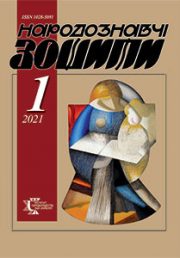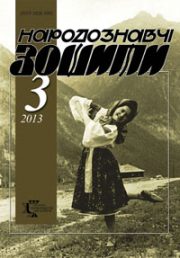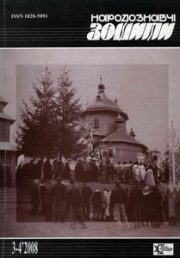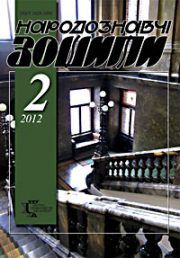The Ethnology Notebooks. 2020. № 2 (152), 370—377
UDK 392 : 638. 17] (= 161. 2) (478)
DOI https://doi.org/10.15407/nz2020.02.370
THE SEMANTIC-FUNCTIONAL YIELD OF WAX IN THE FAMILY RITUALISM OF THE UKRAINIANS OF MOLDOVA
MOVNA Uliana
ORCID ID: http://orcid.org/0000-0002-9763-2455
Doctor of Sciences of History, Senior Researcher
of the Institute of Ethnology of the National Academy
of Sciences of Ukraine,
in the Department of Historical Ethnology,
15, Svobody Avenue, 79000, Lviv, Ukraine
Contacts: e-mail: movlana@ukr.net
Abstract. Among the sacral objects that throughout the long historical tradition of their use have acquired a variety of ritual, magic, protective, healing application, the wax candle perhaps ranks nearly second to none by its status. The flame of the wax candle as one of the centerpieces of the universe was the primary symbol of the life giving and curative energy of the Sun and solar light, the symbol of vital power, fertility, purification. As the incarnation of the heavenly light, the glowing Sun, warmth and brightness, the candle played an important role in the ritual practice of the Ukrainian peasantry being a universally used sacral object, an indispensable attribute of the entire range of family, calendar and occasional rites, religious practices, sacrificial offerings, routine and sacral magic actions, that is, it invariably accompanied all watershed events, comprehended and actualized only within the context of the rite.
Many centuries of Slavonic tradition of ritual use of wax in the extended ritual form were preserved till the 19th — early 20th c. in the Ukrainians’ folk ritualism — celebration of calendar festivities and rituals of human life cycle (birth, wedding, funeral and commemorative), and they still exist in a modified form. The ritual functions of wax candles in folk ritualism — as a mediator between the earthly and the unearthly, symbol of transition to new living status, symbol of human life, symbolic analogue of a human, bearer of apotropaion and cathartic potential — purification of humans and of the deceased soils from the impurity of sin.
In this article we focus our attention on the semantic-functional yield of wax (wax candle) in the context of the traditional wedding and funeral-memorial rites (as more “public” as compared to the authentic and better preserved) of the Ukrainians of Northern Moldova that till present day demonstrate the features of appreciable conservation of numerous archaic elements. The article explores semantic-functional yield of wax in the context of the traditional family (wedding and funeral-memorial) rites as the main research problem. The object of the study is the family ritualism of the Ukrainians of Moldova, and the research subject — semantic-functional yield of wax in its context. The study used comparative, typological, structural-functional methods and method of field researchers.
Since there have been no research works conducted on that subject, the article is based on the field materials gathered by the author in 2007 during the combined historical-ethnographic expedition of the Institute of Ethnology of the National Academy of Sciences of Ukraine to the Ukrainian villages in Moldova (Drochia, Glodeni, Singerei, Floresti districts).
Кeywords: wax, candle, semantic, ritual, Ukrainians, Моldova.
Received 16.03.2020
REFERENCES
Nudga, G. (1976). «De Russorum, Moscovitarum et Tartarorum»… Zhovten’, 10 (Pp. 145—152) [in Ukrainian].
Petrova, N. (2005). Traditional wedding in village Haraba. Ukrainians of Transnistria (materials of ethnographic studies) (Issue 1, pp. 83—93) [in Ukrainian].
Laguna, S. Folk rituals. Folk medicine. Illness of animals. Fortune tellers. In the VR LNNBU im. V. Stefanyka. F. 5. Op. 1. Spr. 4435 [in Polish].
Sikirynski, O. (1925). Ukrainian wedding (village Hlybokojar, Tiraspol district). Visnyk Odeskoji komisii krajeznavstwa pry VUAN (Vol. 2/3, pp. 205—217) [in Ukrainian].
Marfodudinova, M. (Ed.). (2008). Kalyta VI (at cradle to grave). Dnipropetrovsk: Lira LTD [in Ukrainian].
Kusznir, V. and others (2010). Essays of traditional culture of Ukrainians of Odessa District (Mykolaiv Region). Odesa: SMIL [in Ukrainian].
Kusznir, V. and others (2008). Traditional wedding ritualistic of Ukrainians of Odessa District (20—80 year XX century). Odesa: Hermes [in Ukrainian].
Movna, U. (2017). Beekeeping: Ukrainian ritual context. Lviv [in Ukrainian].
Kirkor, A. (1858). Ethnographic view on Vilno District. Ethnographical collection (Vol. 3, pp. 115—276). S. Petersburg [in Russian].
Kolberg, O. (1910). Tarnov-Rrzeshov. Antropology, archaeology and ethnography materials (Vol. 11, pp. 116—323). Krakow [in Polish].
Dvorakovski, S. (1935). Family rituals in Vysoko Mazovia Region. Warszawa [in Polish].
Gaj-Piotrovski, V. (1967). Social culture of peasantry of Rozvadov. Wroclaw [in Polish].
Zabуlin, M. (Ed.). (2004). Russian people (Vol. 1). Moscow [in Russian].
Berezovich, E. (2007). Language and traditional culture: ethnolingvistic study. Moscow: Indrik [in Russian].
Nikitina, A. (2008). Candle in crossing rituals. S. Petersburg [in Russian].
Loginov, K. (2010). Traditional life cycle of Russians of Vodlozerie: rituals, customs, conflicts. Moscow; Petrozavodsk [in Russian].
Afanasiev, A. (1855). About mining of Rod and rozanicy. Archive of historical-juridical news of Russia (Vol. 2, pp. 125—142). Moscow [in Russian].
Barbarin, L. (1995). Wedding on village of Podserednie Bielgorod District. Zhywaja Starina, 3, 36—40 [in Russian].
Veletskaja, N. (1978). Pogan symbolic of Slavonic archaic rituals. Moscow: Nauka [in Russian].
Nestorovsky, P. (1905). Bessarabian Ukrainians: historical-ethnographical essay. Warszawa [in Russian].
Movna, U. (2015). Traditional Ukrainian beekeeping: vocabulary of ethnographical terms. Lviv [in Ukrainian].
Moisei, A. (2010). Agrarian customs and rituals in folk calendar of Westromns people of Bucovina. Czernivtsi: Art Druk [in Ukrainian].
The field studies of Institutes of Ethnography of Academy of Sciences of Soviet Union (1979). Moscow [in Russian].
Rakova, O. (1912). The Funeral customs and rituals in village Raranche, Czernowitz District. Ethnographical collection (Vol. 31/32, pp. 379—384). Lviv [in Ukrainian].







